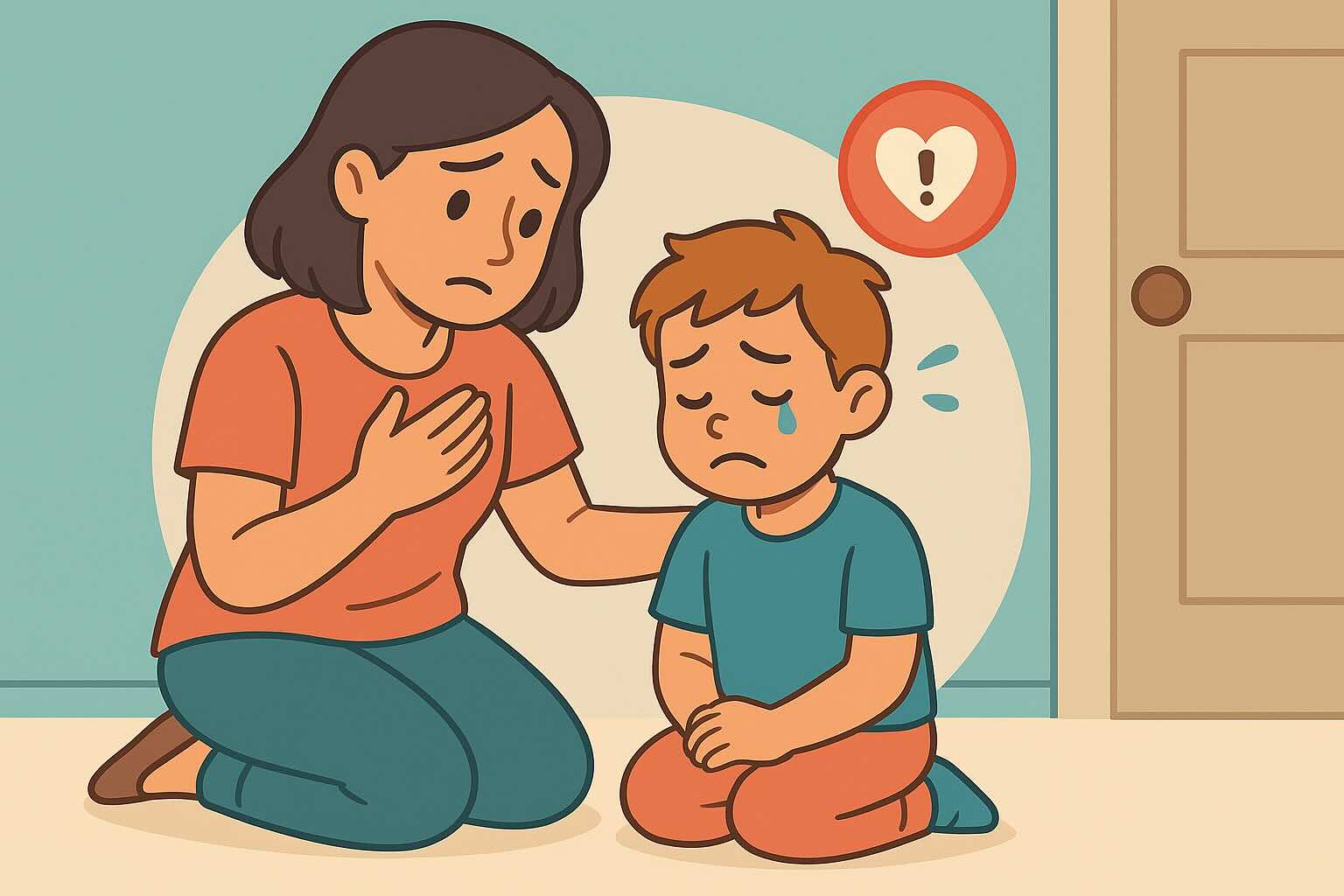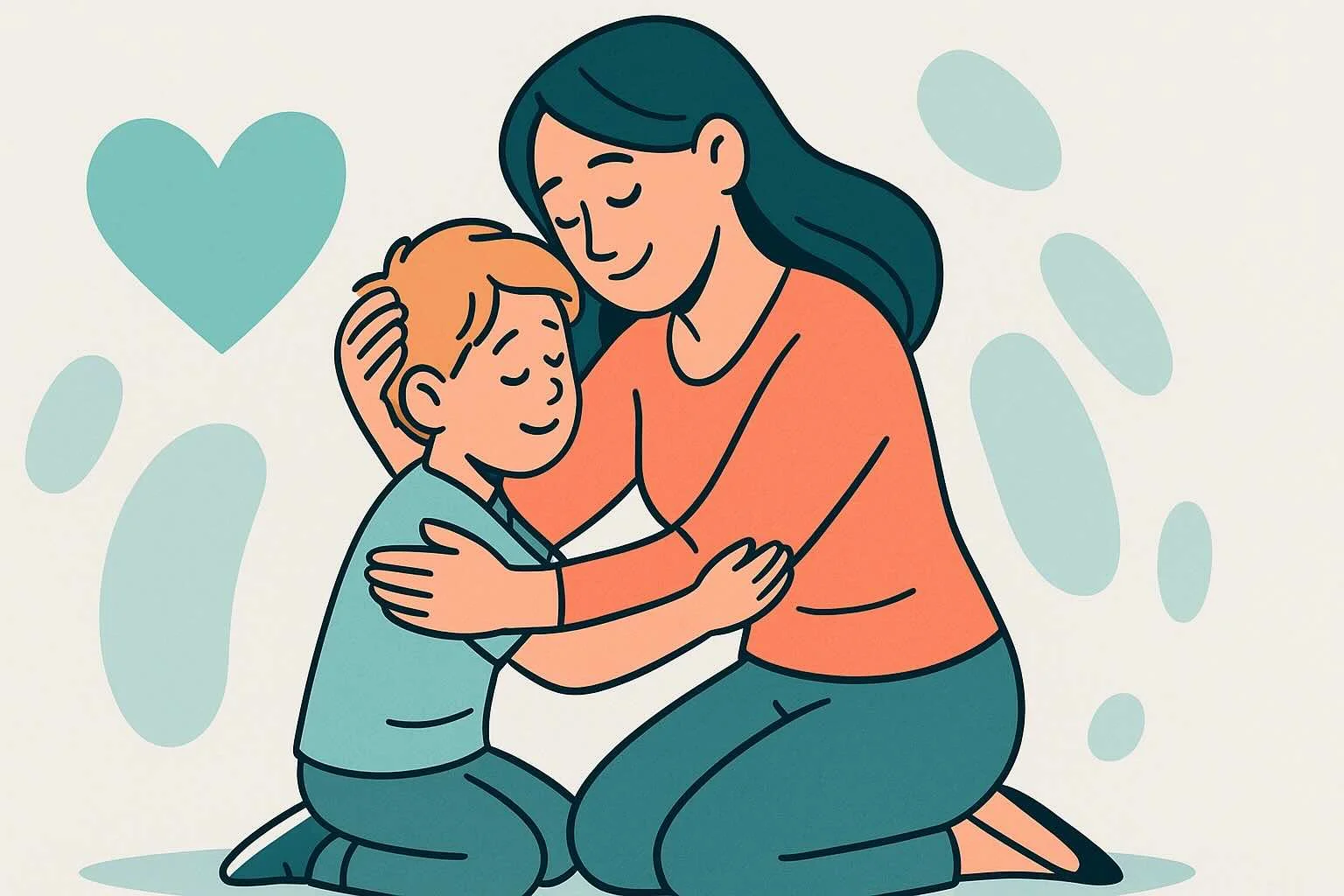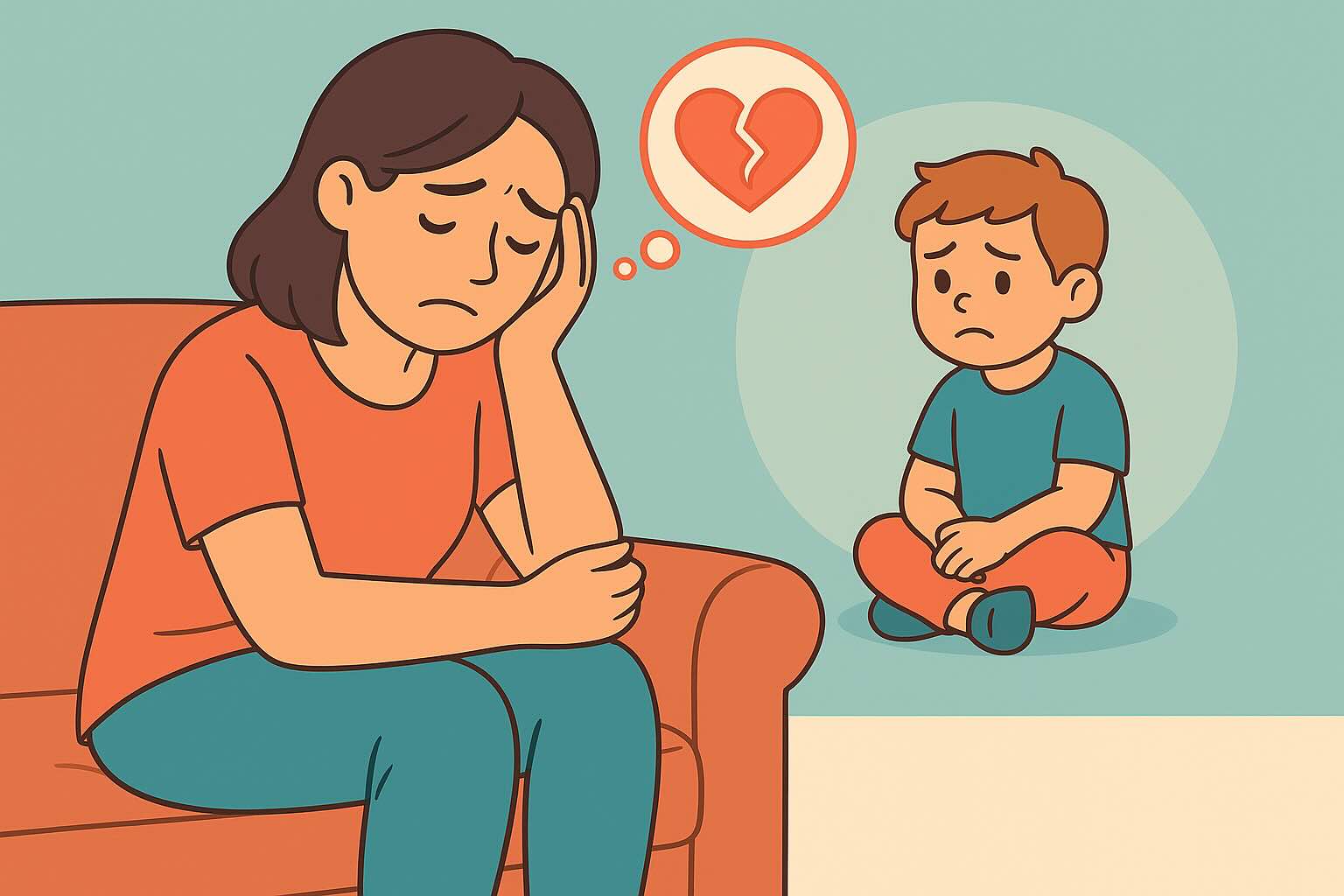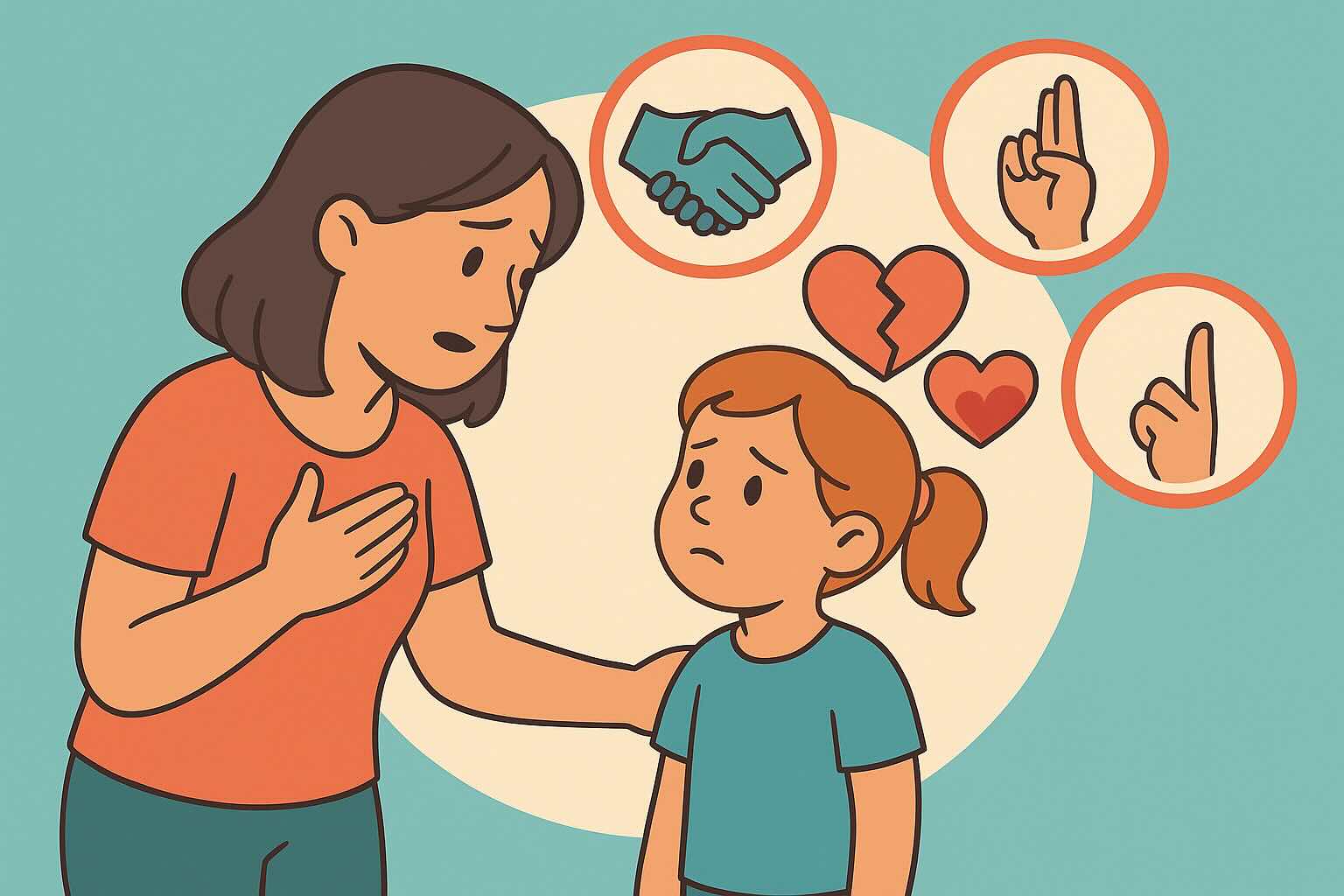What to Do When Youve Been Too Harsh: 4 Steps That Rebuild Trust


If you're reading this with a pit in your stomach, knowing you crossed the line from firm guidance to harshness with your child, take a breath. You are not a monster, and this moment does not define you as a parent. What matters now is how you respond, repair, and rebuild the emotional safety your child needs.
Research shows that even very young children are remarkably resilient when parents take responsibility and work actively to rebuild trust. This guide will show you exactly how to do that, step by step, with immediate actions and long-term strategies.
For related recovery challenges, also check out our guides on overcoming parent guilt and rebuilding trust after broken promises. You may also find our guides on reconnecting after big fights and repairing after losing your cool helpful.
What You'll Learn in This Guide
- Immediate Damage Control - What to do in the first 24 hours after being harsh
- Understanding Harsh vs. Firm - Clear distinctions to prevent future incidents
- Age-Specific Recovery - Different approaches for 3-4 vs. 5-7 year olds
- Rebuilding Emotional Safety - How to help your child feel secure again
- Trust Recovery Timeline - Realistic expectations for relationship healing
- Prevention Strategies - Tools to catch yourself before crossing the line
- Professional Support - When to seek help for patterns of harshness
Estimated reading time: 11 minutes
Understanding Harsh vs. Firm: Where Did You Cross the Line?
What Constitutes "Harsh" Parenting
Harsh parenting involves:
- Using intimidation or fear to control behavior
- Threatening consequences that are out of proportion or impossible to follow through on
- Yelling that feels overwhelming or scary to your child
- Name-calling, character attacks, or shaming language
- Physical positioning that feels threatening (looming over, cornering)
- Emotional punishment (silent treatment, withdrawal of love)
- Threats to abandon or send them away
Firm vs. Harsh: The Crucial Difference
Firm parenting:
- Clear, calm communication of boundaries
- Natural consequences that match the behavior
- Consistent follow-through without emotional reactivity
- Respect for the child's dignity while maintaining expectations
- Teaching and guiding rather than punishing and shaming
Harsh parenting:
- Emotional reactivity and overwhelm
- Consequences driven by anger rather than logic
- Intimidation or fear-based control
- Attacking the child's character rather than addressing behavior
- Power struggles that escalate rather than resolve
Signs You've Been Too Harsh
In the moment, you might have:
- Raised your voice to a scary level
- Made threats you can't or shouldn't follow through on
- Used language that attacked your child's character
- Continued escalating when your child was already upset or scared
- Used your size, position, or authority to intimidate
Your child's reactions might include:
- Looking genuinely scared or shocked
- Freezing, cowering, or trying to hide
- Immediate compliance out of fear rather than understanding
- Crying that seems fearful rather than just upset
- Apologizing repeatedly or saying "I'm sorry" when they've done nothing wrong
Immediate Recovery: The First 24 Hours
Step 1: Regulate Yourself First (First 30 minutes)
Before you can help your child, you need to get your own nervous system regulated.
Immediate self-regulation:
- Take 10 deep breaths
- Get some physical distance temporarily if needed
- Splash cold water on your face
- Do some gentle movement or stretching
- Remind yourself: "I am safe, my child is safe, this can be repaired"
Step 2: Ensure Physical and Emotional Safety (Within 2-4 hours)
Approach your child when you're calm:
- Get on their physical level
- Use a very gentle, quiet voice
- Keep your body language open and non-threatening
- Don't try to "fix" everything immediately
Safety-focused language:
- "You are safe with me."
- "I should not have used my scary voice with you."
- "You don't need to be afraid of me."
- "I made a big mistake, and it wasn't your fault."
Step 3: Take Full Responsibility (Within 4-6 hours)
For ages 3-4: "I used my scary, loud voice with you. That was wrong. You are safe. I love you very much. I'm going to practice using my gentle voice."
For ages 5-7: "I was harsh with you earlier, and that was completely wrong. You didn't deserve to be treated that way. I was feeling [frustrated/overwhelmed/angry], and I handled my feelings badly. You are safe with me, and I'm working on doing better."
Step 4: Focus on Reconnection, Not Resolution
Don't rush to address the original behavior issue. Right now, your only job is helping your child feel emotionally safe again.
Reconnection activities:
- Offer physical comfort if they want it
- Do a quiet, enjoyable activity together
- Read a favorite book together
- Simply be nearby without pressure to talk
Age-Specific Recovery Strategies
Ages 3-4: Concrete Safety and Simple Language
At this age, children think very concretely and may not understand complex emotional explanations.
Key principles:
- Use very simple language (3-5 words per sentence)
- Focus on physical safety and comfort
- Be extra gentle with voice tone and body language
- Offer more physical affection and presence
- Don't expect them to understand your emotional state
Effective approaches:
- "I was too loud. I'm sorry."
- "You are safe with Mommy/Daddy."
- "My loud voice was scary. That was wrong."
- "I love you. You are good."
Avoid:
- Long explanations about your stress or feelings
- Expecting them to understand why you were harsh
- Making them comfort you or say they forgive you
- Returning to the behavior issue too quickly
Ages 5-7: Emotional Understanding and Responsibility
Children this age can understand more about emotions and relationships, but they're still very vulnerable to harshness.
Key principles:
- Acknowledge their emotional experience explicitly
- Explain your responsibility without making excuses
- Validate their right to feel scared or upset
- Involve them in rebuilding safety when they're ready
Effective approaches:
- "I can see that felt really scary when I raised my voice like that."
- "You have every right to feel upset with me about how I acted."
- "I was wrong to be harsh with you, no matter what was happening."
- "Your feelings about this are completely valid and important."
Teaching moments (only after safety is rebuilt):
- "What could help you feel safer when I'm feeling frustrated?"
- "How will you know that I'm working on being gentler?"
- "What would help our family handle difficult moments better?"
Rebuilding Emotional Safety: The Foundation of Trust
Creating a Safe Emotional Environment
Immediate changes to demonstrate safety:
- Lower your voice volume consistently for several days
- Increase your physical presence and availability
- Offer extra patience with normal childhood behaviors
- Create more predictable routines and fewer surprises
- Be extra attentive to their emotional needs
Environmental safety cues:
- Sit at their level when talking
- Keep your body language open and relaxed
- Use gentle touch when appropriate and welcomed
- Make eye contact that feels warm, not intense
- Speak slowly and clearly
Signs Your Child Feels Safe Again
Positive indicators:
- Resuming normal interaction patterns with you
- Coming to you for comfort when upset
- Playing freely without constantly checking your mood
- Expressing normal childhood emotions around you
- Asking for help or making normal requests
Red flags to watch for:
- Continued fearfulness or hypervigilance around you
- Excessive compliance or "walking on eggshells"
- Emotional withdrawal or shutting down
- Regression in behaviors they had mastered
- Seeking comfort primarily from other caregivers
Trust Recovery: What to Expect and How Long It Takes
Realistic Timeline Expectations
Immediate recovery (24-48 hours): Most resilient children will show signs of feeling safer within 1-2 days if this was an isolated incident and repair was genuine and appropriate.
Short-term recovery (1-2 weeks): Full return to normal interaction patterns, comfort seeking you out for help, resumption of typical parent-child dynamics.
Long-term integration (2-4 weeks): Your child processes the experience fully, shows no ongoing effects, and the incident becomes part of their understanding that parents make mistakes and can repair them.
Extended recovery (1-3 months): Some sensitive children or those who've experienced repeated harshness may need longer to fully trust that the changes are permanent.
Factors That Affect Recovery Speed
Faster recovery:
- Single incident rather than pattern
- Child has secure attachment foundation
- Immediate, genuine repair attempts
- Consistent gentle behavior following the incident
- Child has generally resilient temperament
Slower recovery:
- Pattern of harsh parenting over time
- Highly sensitive or anxious child temperament
- Other stressors in the child's life
- Inconsistent repair efforts
- Ongoing family stress or instability
Specific Recovery Scripts for Common Harsh Behaviors
After Yelling That Felt Scary
For ages 3-4: "I used my very, very loud voice with you. That was scary. Your body felt scared. That was wrong. You are safe now. I'm going to practice my quiet voice."
For ages 5-7: "I yelled at you in a way that felt scary and overwhelming. I can see that was frightening for you. You didn't deserve that, no matter what was happening. I was wrong to let my emotions control my voice like that. You are completely safe with me."
After Threatening Harsh Consequences
For ages 3-4: "I said something mean about throwing away your toys. That was not nice. I don't throw away your things. I was angry and said something wrong. I'm sorry."
For ages 5-7: "I threatened consequences that were too harsh and that I don't actually believe in. I was trying to control your behavior through fear, and that was wrong. You should never have to be afraid of what I might do when I'm upset. I'm committed to using fair, reasonable consequences instead."
After Name-Calling or Character Attacks
For ages 3-4: "I called you a mean name. That was very wrong. You are not bad. You are good and I love you. I should never call you names."
For ages 5-7: "I called you [specific words] when I was angry, and that was cruel and unfair. Those words were meant to hurt you, and that's never okay. You are a good person who was having a difficult moment. The way I spoke about you doesn't reflect who you are - it reflects that I lost control of my emotions."
After Using Physical Intimidation
For ages 3-4: "I made my body big and scary near you. That was wrong. Your body should feel safe with me. I will keep my body calm and gentle."
For ages 5-7: "I used my size and position to try to intimidate you, and that was completely inappropriate. You should never feel physically threatened by me. I was using my body to try to control you through fear, and that goes against everything I believe about how people should treat each other."
Prevention: Catching Yourself Before You Cross the Line
Learning Your Warning Signs
Physical warning signs:
- Tension in jaw, shoulders, or hands
- Faster breathing or heart rate
- Feeling hot or flushed
- Clenched fists or teeth
- Feeling like you need to move or pace
Emotional warning signs:
- Thoughts like "This child is driving me crazy"
- Feeling like you need to "teach them a lesson"
- Wanting to make them feel as frustrated as you do
- Feeling out of control or desperate
- Having thoughts about harsh consequences
Situational warning signs:
- Time pressure or feeling rushed
- Already feeling stressed about other things
- Feeling judged by others (in public, with family)
- Hungry, tired, or overwhelmed yourself
- Child is having a particularly difficult day
Emergency Pause Strategies
When you feel harshness building:
- Take 3 deep breaths before speaking
- Lower your voice instead of raising it
- Get on your child's physical level
- Say: "I need a moment to calm down"
- Step away if you can do so safely
- Count to 10 (or 20, or 50)
In-the-moment mantras:
- "My child is not my enemy"
- "This is hard for both of us"
- "I can be firm without being scary"
- "Their behavior is information, not defiance"
- "I want them to cooperate, not comply out of fear"
Creating Family Safety Plans
For ages 5-7, involve them in prevention:
- "What should we do when emotions get really big in our family?"
- "How can you let me know if my voice is getting too loud?"
- "What helps you feel safest when there's conflict?"
- "What code word can we use when someone needs a break?"
When to Seek Professional Support
Red Flags That Indicate Need for Help
Concerning patterns:
- Harshness occurring multiple times per week
- Increasing intensity of harsh moments over time
- Your child showing signs of trauma responses (nightmares, regression, excessive fearfulness)
- Feeling unable to control your anger even with awareness
- Your child consistently choosing other caregivers over you
- Physical aggression accompanying emotional harshness
Your own warning signs:
- Feeling like you hate your child in angry moments
- Having thoughts about abandoning or giving up your child
- Using harshness as your primary discipline strategy
- Feeling vindicated or justified in your harshness
- Unable to repair genuinely or keep blaming your child
Types of Professional Support Available
Individual therapy for parents:
- Anger management and emotional regulation skills
- Processing your own childhood experiences
- Stress management and coping strategies
- Developing realistic parenting expectations
Family therapy:
- Rebuilding parent-child relationships
- Improving family communication patterns
- Creating healthier conflict resolution strategies
- Addressing ongoing family dynamics
Parent training programs:
- Evidence-based positive parenting strategies
- Age-appropriate discipline techniques
- Understanding child development and behavior
- Building emotional regulation skills for the whole family
Self-Forgiveness and Moving Forward
Moving from Shame to Accountability
Shame-based thinking:
- "I'm a terrible parent"
- "I've damaged my child forever"
- "I'm just like my own harsh parent"
- "My child will never forgive me"
Accountability-based thinking:
- "I made a serious mistake and I'm taking responsibility"
- "Children are resilient when parents do repair work"
- "I can learn from this and do better"
- "My child deserves my best efforts to change"
Creating Your Personal Prevention Plan
Daily practices:
- Morning check-ins with your emotional state
- Midday stress level assessments
- Evening reflection on parenting moments
- Regular self-care to prevent emotional overload
Weekly planning:
- Identify high-stress times and plan support
- Review any harsh moments and extract learning
- Celebrate successful emotional regulation
- Adjust strategies based on what's working
Monthly growth assessment:
- Track patterns in harsh moments
- Assess your child's overall emotional safety with you
- Evaluate need for additional support or resources
- Set specific goals for continued improvement
Your 6-Week Recovery and Prevention Plan
Week 1: Immediate Repair and Safety
- Focus entirely on rebuilding emotional safety
- Use gentle voice and body language consistently
- Offer extra comfort and presence
- Don't address original behavior issues yet
Week 2: Strengthening Connection
- Engage in enjoyable activities together
- Practice emotional regulation skills yourself
- Begin identifying your warning signs
- Continue gentle, patient interactions
Week 3: Understanding and Prevention
- Reflect on what led to the harsh moment
- Develop specific prevention strategies
- Practice pause techniques
- Involve older children in safety planning
Week 4: Skill Building
- Learn age-appropriate discipline alternatives
- Practice firm but gentle boundary-setting
- Continue monitoring your child's emotional safety
- Seek support if patterns continue
Week 5: Integration and Practice
- Apply new skills consistently
- Address any remaining trust issues
- Build confidence in your ability to stay regulated
- Plan for challenging situations
Week 6: Long-term Maintenance
- Establish ongoing prevention habits
- Create family emotional safety protocols
- Celebrate growth and progress
- Plan for continued learning and support
Key Takeaways: Your Recovery Roadmap
- ✅ Immediate safety is the first priority, not addressing the original behavior
- ✅ Full responsibility without excuses or blame is essential for trust repair
- ✅ Age-appropriate approaches help children process the experience appropriately
- ✅ Emotional safety must be rebuilt before normal parenting can resume
- ✅ Recovery timelines vary but most children are remarkably resilient
- ✅ Prevention strategies help you catch yourself before crossing the line
- ✅ Professional support is available when patterns persist
- ✅ Self-forgiveness and accountability work together for lasting change
- ✅ Children's resilience is remarkable when paired with genuine repair efforts
Remember: One harsh moment does not define your parenting or damage your child permanently. Your commitment to repair, change, and growth is what matters most.
This article is based on attachment theory, trauma-informed parenting approaches, and clinical experience in family therapy. If harsh parenting is a pattern, please seek professional support. Every child deserves to feel emotionally safe with their caregivers.
Multi-Child Support
Manage profiles for multiple children with personalized conversations and age-appropriate advice for each child.

Parent Repair Scripts
Word-for-word scripts for rebuilding trust and modeling accountability after losing your cool with your child.
Frequently Asked Questions
Need personalized support?
RootWise's AI coach can provide tailored strategies for your specific situation, available 24/7 when you need it most.
Learn More About AI Coaching →



